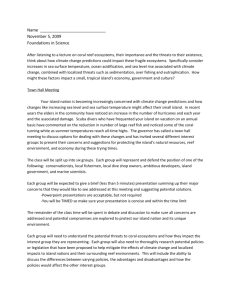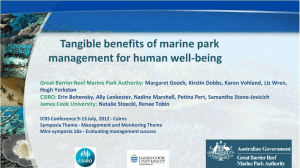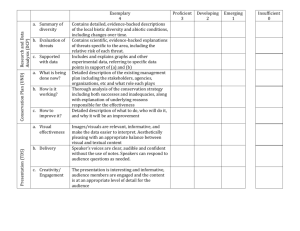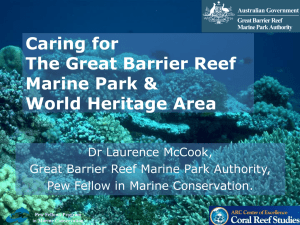jbi12647-sup-0001-AppendixS1-S3
advertisement
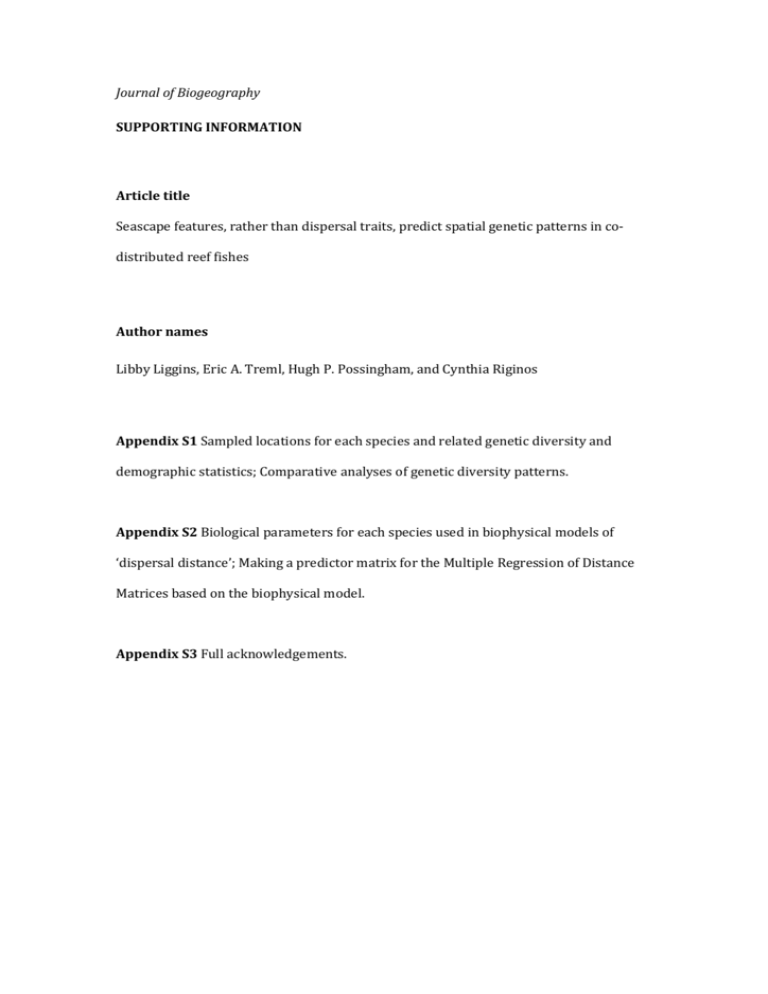
Journal of Biogeography SUPPORTING INFORMATION Article title Seascape features, rather than dispersal traits, predict spatial genetic patterns in codistributed reef fishes Author names Libby Liggins, Eric A. Treml, Hugh P. Possingham, and Cynthia Riginos Appendix S1 Sampled locations for each species and related genetic diversity and demographic statistics; Comparative analyses of genetic diversity patterns. Appendix S2 Biological parameters for each species used in biophysical models of ‘dispersal distance’; Making a predictor matrix for the Multiple Regression of Distance Matrices based on the biophysical model. Appendix S3 Full acknowledgements. Appendix S1. Sampled locations for each species and related genetic diversity and demographic statistics: nucleotide diversity, π; haplotype diversity, Hd; effective number of haplotypes, He; number of private haplotypes, Hp; Tajima’s D; and Fu’s Fs. Significance of demographic statistics denoted by asterisks: *P < 0.05, **P < 0.01, ***P < 0.001. Species/Location Longitude, latitude n π Hd He Hp D Fs Pomacentrus coelestis NIN Ningaloo reef 113.98°E, 21.73°S 24 0.0150 0.9964 22.15 19 -1.47 -22.06*** ASH Ashmore reef 123.13°E, 12.24°S 32 0.0151 0.9839 21.33 21 -1.04 -23.38*** TIM Timor l'este 126.42°E, 8.30°S 19 0.0198 0.9649 11.65 12 -1.20 -6.94** WIG Wigram Island 136.57°E, 11.76°S 16 0.0141 0.9417 8.53 7 -0.95 -4.59* Lizard Island 145.49°E, 14.69°S 16 0.0120 0.9619 9.78 5 -0.89 -5.53** MOT Motupore Island 147.24°E, 9.44°S 15 0.0112 0.9714 10.71 8 -1.36 -8.53*** KAV Kavieng 150.78°E, 2.57°S 17 0.0110 0.9485 16.00 9 -1.55* -7.08*** Lihou reef 151.53°E, 17.62°S 11 0.0087 0.9636 8.07 4 -1.01 -4.58** HER Heron Island 151.93°E, 23.49°S 20 0.0087 0.9474 10.00 10 -1.76* -12.89*** MOO Mooloolaba 153.12°E, 26.64°S 19 0.0136 0.9591 10.94 8 -1.49 -8.07*** LIZ LIH SLT Solitary Islands 153.15°E, 30.32°S 14 0.0100 0.9341 7.54 7 -1.74* -5.43** SOL Solomon Islands 157.41°E, 8.17°S 16 0.0063 0.8250 4.41 8 -1.99* -4.85** LDH Lord Howe Island 159.07°E, 31.52°S 18 0.0114 0.9281 8.10 6 -1.11 -6.10** Dascyllus trimaculatus CHA Chagos archipelago 72.01°E, 6.08°S 18 0.0239 0.9608 10.80 12 -0.30 -1.09 NIN Ningaloo reef 113.98°E, 21.73°S 15 0.0144 0.9429 8.33 9 -1.06 -4.42* ASH Ashmore reef 123.13°E, 12.24°S 17 0.0154 0.9853 13.76 10 -1.21 -7.98 TIM Timor l'este 126.42°E, 8.30°S 16 0.0142 1.0000 16.00 8 -1.59* -13.11*** LIZ Lizard Island 145.49°E, 14.69°S 15 0.0120 0.9619 9.78 5 -0.89 -5.53** Motupore Island 147.24°E, 9.44°S 16 0.0123 0.9667 10.67 7 -1.17 -6.39** MOT KAV Kavieng 150.78°E, 2.57°S 16 0.0137 1.0000 16.00 8 -1.84* -13.17*** LIH Lihou reef 151.53°E, 17.62°S 6 0.0138 0.9333 4.50 3 -1.07 -0.33 SOL Solomon Islands 157.41°E, 8.17°S 17 0.0141 0.9853 13.76 9 -1.12 -8.60*** Fiji 177.67°E, 16.73°S 5 0.0109 1.0000 5.00 1 -1.19 -1.72 TGA FIJ Tonga 175.20°W, 21.18°S 15 0.0149 0.9810 11.84 8 -0.26 -6.11** COK Cook Islands 159.78°W, 21.24°S 9 0.0369 0.8333 3.86 5 1.79 2.32 Halihcoeres hortulanus CHA Chagos archipelago 72.01°E, 6.08°S 29 0.0091 0.9089 8.17 12 -1.37 -9.26*** ASH Ashmore reef 123.13°E, 12.24°S 15 0.0189 0.9905 13.24 8 0.22 -7.01** TIM Timor l'este 126.42°E, 8.30°S 5 0.0234 1.0000 5.00 2 0.69 -0.57 LIZ Lizard Island 145.49°E, 14.69°S 15 0.0208 0.9905 13.24 9 0.38 -6.53** MOT Motupore Island 147.24°E, 9.44°S 15 0.0194 0.9905 13.24 6 1.35 -6.85** KAV Kavieng 150.78°E, 2.57°S 16 0.0237 0.9830 12.80 9 0.04 -4.89* LIH Lihou reef 151.53°E, 17.62°S 16 0.0196 0.9750 11.64 8 0.24 -5.71** SOL Solomon Islands 157.41°E, 8.17°S 15 0.0162 0.9619 9.78 7 -0.58 -4.09* Fiji 177.67°E, 16.73°S 5 0.0150 1.0000 5.00 1 -0.45 -1.22 Tonga 175.20°W, 21.18°S 16 0.0168 0.9667 10.67 8 -0.39 -4.82* FIJ TGA Acanthurus triostegus NIN Ningaloo reef 113.98°E, 21.73°S 18 0.0046 0.8366 4.77 3 -1.07 -1.30 ASH Ashmore reef 123.13°E, 12.24°S 15 0.0022 0.7048 2.92 1 -0.95 -1.06 TIM Timor l'este 126.42°E, 8.30°S 15 0.0058 0.7714 3.57 2 -0.57 0.60 LIZ Lizard Island 145.49°E, 14.69°S 15 0.0069 0.9143 6.82 5 -0.68 -1.71 MOT Motupore Island 147.24°E, 9.44°S 7 0.0038 0.8095 3.27 0 -0.77 0.75 KAV Kavieng 150.78°E, 2.57°S 15 0.0051 0.8190 4.25 3 -1.31 0.24 LIH Lihou reef 151.53°E, 17.62°S 15 0.0037 0.8857 5.77 4 -1.37 -2.78 SOL Solomon Islands 157.41°E, 8.17°S 15 0.0047 0.8667 5.23 0 -1.22 -0.92 TUV Tuvalu 179.20°E, 8.52°S 16 0.0065 0.8250 4.41 3 -0.82 -1.61 FIJ Fiji 177.67°E, 16.73°S 11 0.0045 0.8727 4.84 3 -1.22 -1.10 TGA Tonga 175.20°W, 21.18°S 7 0.0067 0.9524 5.44 2 -0.18 -0.93 COK Cook Islands 159.78°W, 21.24°S 30 0.0045 0.8345 5.17 6 -1.38 -1.41 Hawaii 158.00°W, 21.41°N 11 0.0053 0.9455 7.12 8 0.24 -1.86 HAW Comparative analyses of genetic diversity patterns Methods We used MANOVA to analyze differences in genetic diversity and demographic history at the seven locations where all species were co-sampled (using the R base stats package). ‘Location’ and ‘species’ were used as factors, and nucleotide diversity π, haplotype diversity Hd, effective number of haplotypes He, number of private haplotypes Hp, Tajima’s D, and Fu’s Fs were our response variables (see Appendix S1 in Supporting Information). We expected that values would differ among species, but that the patterns across species would be congruent. Specifically, we hypothesized that there would be a pattern of higher genetic diversity in locations closest to the junction of the Indian and Pacific Oceans (i.e. highest values in TIM, ASH, MOT), and that values for Tajima’s D and Fu’s Fs would decrease away from the this region, indicative of more recent colonization, population expansion, and no population admixture (i.e. lowest values in KAV, SOL, LIH; H05). Results MANOVA revealed there was no effect of location on the raw, or scaled and centred, genetic response measures (Pillai’s Trace = 1.67, F6,36 = 1.15, P = 0.2825) but there was a significant effect of species (Pillai’s Trace = 2.17, F3,18 = 6.56, P < 0.0001). Most of the variables were suitably correlated for MANOVA (i.e. r = 0.20 - 0.60, Meyers et al. 2006), however Hd was excluded from the MANOVA analysis as it was highly correlated with π and He (r > 0.75) and did not have a normal distribution following transformation. Some response measures were also negatively correlated with each other. This is expected given the way that the different genetic measures are derived, but can interfere with the performance of a MANOVA. Therefore, we additionally performed two-factor univariate analyses of variance. The univariate relationships confirmed that species had an effect on all the genetic measures, but also indicated that values for Tajima’s D varied consistently across species for some locations (F6,18 = 2.77, P = 0.0435). A Tukey’s test for Honestly Significant Differences revealed that this result was driven by two significant pairwise relationships among locations; KAV had significantly lower values for Tajima’s D than both LIZ and MOT (after Tukey’s test: LIZ-KAV, diff = 2.076, P = 0.0140; MOTKAV = 1.992, P = 0.0200). Other than this result, there was little quantitative support for our prediction that values of genetic diversity and demographic measures would decrease away from the junction of the Indian and Pacific Oceans (H05). Discussion MANOVA suggested there were no differences among statistical estimates of genetic diversity across the co-sampled study region (P > 0.05). The single exception was Tajima’s D. Tajima’s D behaved as we predicted: significantly lower values were found at a location most distant from the junction of the Indian and Pacific Oceans (H05). The low values for Tajima’s D suggest that all four reef fish species have a relatively recent and isolated population history in Kavieng. Few studies have included Kavieng in their genetic surveys. Although Barber et al. (2006) found a divergent lineage that was shared with the northern part of mainland Papua New Guinea in three stomatopod species, only one of these species had a signature of population expansion. References Barber, P. H., Erdmann, M. V., & Palumbi, S. R. (2006) Comparative phylogeography of three codistributed stomatopods: origins and timing of regional lineage diversification in the coral triangle. Evolution, 60, 1825–1839. Meyers, L. S., Gamst, G., & Guarino, A. J. (2006) Applied multivariate research: Design and interpretation. Sage Publication, Thousand Oaks, CA. Appendix S2. Biological parameters for each species used in biophysical models of ‘dispersal distance’. Biological parameters were selected from published literature where possible, or were nominated based on the expected dispersal characteristics of each species (i.e. ‘Nominated by authors’). The biological parameters used in the models included: Spawning frequency – ‘year round’ or ‘lunar’; max. Pelagic Larval Duration (PLD) – max. published larval duration in days; Competency – the period following which larvae are competent to settle to a reef habitat; Homing – ‘yes’ or ‘no’, whether larvae actively seek reef habitat using their sensory ability; Mortality – mortality rate per day. Species/biological parameter Pomacentrus coelestis Spawning frequency Max. PLD Competency Source Year round Kokita, 2004; Thorrold & Milicich, 1990; Milicich & Doherty, 1994 Kavanagh & Alford 2003; Thresher et al. 1989 Wellington & Victor, 1989 Homing Mortality 25 days 50% at day 10; 7 to 12 day transition yes 10%/day Dascyllus trimaculatus Spawning frequency Max. PLD Competency Homing Mortality Year round 30 days 23 +/- 2 days no 10%/day Nominated by authors Wellington & Victor, 1989 Weersing & Toonen, 2009 Nominated by authors Nominated by authors Halihcoeres hortulanus Spawning frequency Max. PLD Competency Homing Mortality Lunar 37 days 25 +/- 5 days Yes 10%/day Nominated by authors Victor, 1986 Nominated by authors Nominated by authors Nominated by authors Acanthurus triostegus Spawning frequency Max. PLD Lunar 70 days Competency Homing 25 +/- 5 days yes Mortality 10%/day Nominated by authors Planes, 1993; Planes et al. 1994; Planes & Fauvelot, 2002; Wilson & McCormick, 1999 Nominated by authors Planes, 1993; Planes et al. 1994; Planes & Fauvelot, 2002 Nominated by authors Gerlach et al. 2007 Nominated by authors Making a predictor matrix for the Multiple Regression of Distance Matrices based on the biophysical model. The biophysical model (Treml et al. 2012) outputs the probability that larvae released in one location survive and settle in every other recipient location. Migration matrices were then converted using log(M−1) to be the same rank-order as geographic distance (high proportion of settlers then have a short ‘distance’). The average of the asymmetrical migration matrices was used as the predictor matrix. References Gerlach, G., Atema, J., Kingsford, M. J., Black, K. P., & Miller-Sims, V. (2007) Smelling home can prevent dispersal of reef fish larvae. Proceedings of the National Academy of Sciences, 104, 858–863. Kavanagh, K. D., & Alford, R. A. (2003) Sensory and skeletal development and growth in relation to the duration of the embryonic and larval stages in damselfishes (Pomacentridae). Biological Journal of the Linnean Society, 80, 187–206. Kokita, T. (2004) Latitudinal compensation in female reproductive rate of a geographically widespread reef fish. Environmental Biology of Fishes, 71, 213–224. Milicich, M. M., & Doherty, P. P. (1994) Larval supply of coral reef fish populations: magnitude and synchrony of replenishment to Lizard Island, Great Barrier Reef. Marine Ecology Progress Series, 110, 121–134. Planes, S. (1993) Genetic differentiation in relation to restricted larval dispersal of the convict surgeonfish, Acanthurus triostegus, in French Polynesia. Marine Ecology Progress Series, 98, 237–246. Planes, S., & Fauvelot, C. (2002) Isolation by distance and vicariance drive genetic structure of a coral reef fish in the Pacific Ocean. Evolution, 56, 378–399 Planes, S., Borsa, P., Galzin, R., & Bonhomme, F. (1994) Geographic structure and gene flow in the Manini (convict surgeonfish, Acanthurus triostegus) in South Central Pacific. Genetics and evolution of aquatic organisms (ed. by A. R. Beaumont), pp 113-122. Chapman & Hall, London. Thorrold, S. R., & Milicich, M. J. (1990) Comparison of larval duration and pre-and postsettlement growth in two species of damselfish, Chromis atripectoralis and Pomacentrus coelestis (Pisces: Pomacentridae), from the Great Barrier Reef. Marine Biology, 105, 375– 384. Treml, E. A., Roberts, J., Chao, Y., Halpin, P. N., Possingham, H. P., & Riginos, C. (2012) Reproductive output and duration of the pelagic larval stage determine seascape-wide connectivity of marine populations. Integrative and Comparative Biology, 52, 525–537. Thresher, R. E., Colin, P. L., & Bell, L. J. (1989) Planktonic duration, distribution and population structure of western and central Pacific damselfishes (Pomacentridae). Copeia, 420–434. Victor, B. C. (1986) Duration of planktonic larval stage of one hundred species of Pacific and Atlantic wrasses (family Labridae). Marine Biology, 90, 317–326. Weersing, K. & Toonen, R. J. (2009) Population genetics, larval dispersal, and connectivity in marine systems. Marine Ecology Progress Series, 393, 1–12. Wellington, G. M., & Victor, B. C. (1989) Planktonic larval duration of one hundred species of Pacific and Atlantic damselfishes (Pomacentridae). Marine Biology, 101, 557– 567. Wilson, D. T., & McCormick, M. I. (1999) Microstructure of settlement-marks in the otoliths of tropical reef fishes. Marine Biology, 134, 29–41. Appendix S3. Full acknowledgements All fish sampling was undertaken with the authority of The University of Queensland Animal Ethics Committee (Approval Number: SIB/817/08/ARC). Sampling in TimorLeste was supported by the Coral Triangle Support Partnership and the Ministério da Aquicultura e Pescas, Direcção Nacional de Pescas e Aquicultura (authorised by A Fernandes, L Fontes, J Freitas; guia de marssa: 502/DNPA/VIII/10 and 452/DNPA/VII/11). Export of samples was authorised by the Departmento de Quarentena das Pescas (export permit: 162/FQ006/EXP./DNQB/VII/2011). Sampling in the Solomon Islands was via the Australian Government’s Pacific Strategy Assistance Program and with the assistance of the Roviana Conservation Foundation (Solomon Islands Government Ministry of Education & Human Resource Development and Ministry of Fisheries & Marine Resources research permit to S Albert). Sampling in Papua New Guinea was in coordination with the National Research Institute, the Department of Foreign Affairs and Immigration (Research Visa: 10350008304) and the Department of Environment and Conservation (Permit to Export Wildlife: 011318). Authority to sample at Ashmore Reef was provided by the Australian Government Department of Sustainability, Environment, Water, Population & Communities (Access to Biological Resources in a Commonwealth Area for Non-Commercial Purposes permit number: AU-COM2010068) and with logistic support from Australian Customs and border control. Sampling in the Coral Sea was supported by the Marine Division of the Australian Government Department of Sustainability, Environment, Water, Population & Communities (Access to Biological Resources in a Commonwealth Area for NonCommercial Purposes permit number: AU-COM2008042). Authority to sample at Wigram Island was provided by the Northern Territory Government Department of Resources (Special Permit Number: 2007-2008/S17/2696). Sampling at Ningaloo Reef was under the authority of the Western Australia Department of Environment & Conservation (License to take Fauna for Scientific Purposes: SF007126, SF006619; Authority to enter calm land/or waters: CE002227, CE002627). We are grateful to DJ Booth and W Figueira for providing samples from New South Wales. We are grateful to B Bowen for providing samples from Oahu and the Cook Islands. Sampling in Tonga was under the authority of the Ministry of Agriculture, Food, Forests, and Fisheries (permit issued to J Drew, Ref: F1/37/09, MOFISH (CAB) 02/09). Sampling in Tuvalu was under the authority of the Ministry of Natural Resources and Environment (permit issued to J Drew). Sampling in Fiji was under the authority of the Government of Fiji with a Ministry of Primary Industries Fisheries Department permit: C564/2009. For sampling on the Chagos Archipelago, we thank M Gaither, C Sheppard, J Turner, and D Wagner, the California Academy of Sciences, The Darwin Foundation, The Chagos Conservation Trust, BIOT Administration and CCT for permitting and facilitating the expedition. We are grateful to the staff of the Australian Museum Lizard Island Research Station and Heron Island Research Station for their facilities and support (Great Barrier Reef Marine Park Authority and Queensland Parks and Wildlife Marine Parks Permit: G08/28114.1, G09/31678.1, G10/33597.1, G11/34640.1; Queensland Government Department of Primary Industries General Fisheries Permit: 118636, 150981; Australian Quarantine Inspection Service Permit to Import Quarantine Material: IP10017966). We especially thank JD Aguirre, J Aini (Ailan Awareness), S Albert, K Davis, M Jimuru, J Keyse, J Kinch (National Fisheries College, Papua New Guinea), W Lovell (Freeflow Dive, Dili), I McLeod, A Mirams, S Penny, R Pinto (and staff of the Coral Triangle Support Partnership), A Smith (Tiki2 Adventure Tours), T Sinclair-Taylor, A Turner, P Waldie, MX Weber, Stephen, Lavud, and Takenda for logistical support and field assistance, and J Hannan and JD Aguirre for images of the study species.
